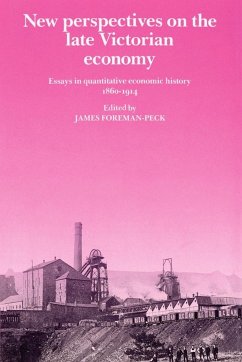The book focuses upon industrial organisation and technology, wages and living standards, and the monetary system.
Through channels both open and concealed, the Victorian economy continues to influence us powerfully. Much economic thinking today gains support from perceptions of how the nineteenth-century British economy worked and how well it satisfied wants. Contemporary oligopolistic industrial structure is contrasted with Victorian self-regulating competition; the gross inequalities of Victorian laissez-faire are compared with support for the needy provided by the modern welfare state; and some regard Victorian values as vital principles of social organisation which should be regained. By examining the behaviour of the British economy between 1865 and 1914, the present work casts light upon some of these views. It does so in a variety of ways. New methods or evidence are deployed to establish accepted conclusions more firmly; unwarrantedly neglected aspects of the economy are analysed with present day concerns in mind; and traditional conclusions are reassessed. The book focuses upon three central themes: industrial organisation and technology, wages and living standards, and the monetary system. These are at the heart of discussions of productivity growth, the standard of living, well-being and poverty; the criteria by which the Victorian economic system should ultimately be judged.
Table of content:
List of contributors; List of figures; List of tables; Preface; 1. Quantitative analysis of the Victorian economy James Foreman-Peck; Part I. Technology and Industrial Organisation: 2. Historical trends in international patterns of technological innovation John Cantwell; 3. Railways and late Victorian economic growth James Foreman-Peck; 4. Emergence of gas and water monopolies in nineteenth-century Britain: contested markets and public control Bob Milward; 5. The expansion of British multinational companies: testing for managerial failure Stephen Nicholas; Part II. Distribution: 6. A new look at the cost of living 1870-1914 Charles Feinstein; 7. Poor law statistics and the geography of economic distress Humphrey Southall; 8. Perfect equilibrium down the pit John G. Treble; Part III. The Monetary System and Monetary Policy: 9. Money, interest rates and the Great Depression: Britain from 1870 to 1913 Forrest H. Capie, Terence C. Mills and Geoffrey E. Wood; 10. The UK demand for money, commercial bills and quasi-money assets, 1871-1913 Paul Turner; 11. An analysis of Bank of England discount and advance behaviour 1870-1914 Tessa Ogden; Index.
Hinweis: Dieser Artikel kann nur an eine deutsche Lieferadresse ausgeliefert werden.
Through channels both open and concealed, the Victorian economy continues to influence us powerfully. Much economic thinking today gains support from perceptions of how the nineteenth-century British economy worked and how well it satisfied wants. Contemporary oligopolistic industrial structure is contrasted with Victorian self-regulating competition; the gross inequalities of Victorian laissez-faire are compared with support for the needy provided by the modern welfare state; and some regard Victorian values as vital principles of social organisation which should be regained. By examining the behaviour of the British economy between 1865 and 1914, the present work casts light upon some of these views. It does so in a variety of ways. New methods or evidence are deployed to establish accepted conclusions more firmly; unwarrantedly neglected aspects of the economy are analysed with present day concerns in mind; and traditional conclusions are reassessed. The book focuses upon three central themes: industrial organisation and technology, wages and living standards, and the monetary system. These are at the heart of discussions of productivity growth, the standard of living, well-being and poverty; the criteria by which the Victorian economic system should ultimately be judged.
Table of content:
List of contributors; List of figures; List of tables; Preface; 1. Quantitative analysis of the Victorian economy James Foreman-Peck; Part I. Technology and Industrial Organisation: 2. Historical trends in international patterns of technological innovation John Cantwell; 3. Railways and late Victorian economic growth James Foreman-Peck; 4. Emergence of gas and water monopolies in nineteenth-century Britain: contested markets and public control Bob Milward; 5. The expansion of British multinational companies: testing for managerial failure Stephen Nicholas; Part II. Distribution: 6. A new look at the cost of living 1870-1914 Charles Feinstein; 7. Poor law statistics and the geography of economic distress Humphrey Southall; 8. Perfect equilibrium down the pit John G. Treble; Part III. The Monetary System and Monetary Policy: 9. Money, interest rates and the Great Depression: Britain from 1870 to 1913 Forrest H. Capie, Terence C. Mills and Geoffrey E. Wood; 10. The UK demand for money, commercial bills and quasi-money assets, 1871-1913 Paul Turner; 11. An analysis of Bank of England discount and advance behaviour 1870-1914 Tessa Ogden; Index.
Hinweis: Dieser Artikel kann nur an eine deutsche Lieferadresse ausgeliefert werden.








